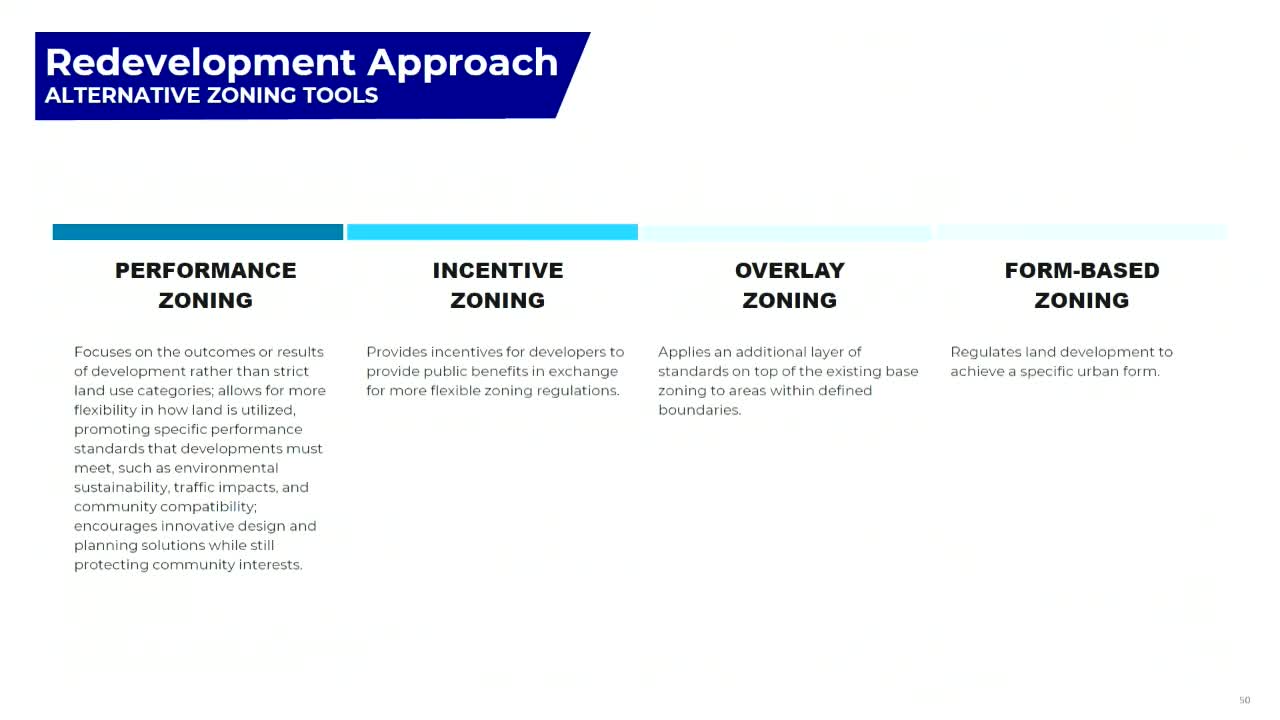Master Plan Proposes Innovative Zoning Tools for Gateway's Sustainable Development
September 08, 2025 | Howard County, Maryland
This article was created by AI summarizing key points discussed. AI makes mistakes, so for full details and context, please refer to the video of the full meeting. Please report any errors so we can fix them. Report an error »

The recent monthly meeting in Howard County, Maryland, focused on the ambitious plans for the Gateway area, emphasizing the need for innovative zoning tools and sustainable design practices. As the community grapples with increasing housing demands and infrastructure needs, the discussions highlighted a vision that aims to transform Gateway into a vibrant, walkable neighborhood.
A key topic was the exploration of alternative zoning tools to facilitate the development of public amenities, infrastructure, and affordable housing. Current zoning regulations do not adequately support the proposed vision, prompting recommendations for performance zoning, incentive zoning, overlay zoning, and form-based zoning. Stakeholders expressed a preference for overlay zoning, which would allow existing uses to remain while accommodating new developments. This approach aims to balance growth with the preservation of the community's character.
The master plan also emphasizes sustainable design, aligning with the county's Climate Action and Resiliency Plan. Strategies discussed include decarbonization efforts, such as creating a multimodal transportation network that promotes walking, biking, and electric vehicle use. High-performance buildings designed to reduce energy demand and integrate renewable energy sources were also highlighted as essential components of this vision.
Resiliency strategies were another focal point, addressing climate-related challenges through water treatment and reuse systems, which can alleviate pressure on public water supplies during droughts. The plan aims to mitigate the urban heat island effect by incorporating green spaces and light-colored materials, enhancing the overall livability of the area.
Transportation and mobility improvements were discussed as vital to transforming Gateway into a welcoming space for all modes of travel. Proposed enhancements include new bike and pedestrian pathways connecting Gateway to neighboring communities and a potential new vehicular access point along Maryland 175 to ease congestion and improve traffic distribution.
The meeting underscored the importance of a comprehensive transportation demand management plan, which would encourage non-automotive transit options and promote sustainable commuting practices among residents and employees.
In summary, the discussions at the Howard County meeting reflect a proactive approach to urban planning, focusing on sustainable development and community connectivity. As the Gateway area moves forward with these plans, the community can anticipate a more integrated and environmentally friendly neighborhood that meets the needs of its residents. Further evaluations and collaborations will be necessary to refine these proposals and ensure their successful implementation.
A key topic was the exploration of alternative zoning tools to facilitate the development of public amenities, infrastructure, and affordable housing. Current zoning regulations do not adequately support the proposed vision, prompting recommendations for performance zoning, incentive zoning, overlay zoning, and form-based zoning. Stakeholders expressed a preference for overlay zoning, which would allow existing uses to remain while accommodating new developments. This approach aims to balance growth with the preservation of the community's character.
The master plan also emphasizes sustainable design, aligning with the county's Climate Action and Resiliency Plan. Strategies discussed include decarbonization efforts, such as creating a multimodal transportation network that promotes walking, biking, and electric vehicle use. High-performance buildings designed to reduce energy demand and integrate renewable energy sources were also highlighted as essential components of this vision.
Resiliency strategies were another focal point, addressing climate-related challenges through water treatment and reuse systems, which can alleviate pressure on public water supplies during droughts. The plan aims to mitigate the urban heat island effect by incorporating green spaces and light-colored materials, enhancing the overall livability of the area.
Transportation and mobility improvements were discussed as vital to transforming Gateway into a welcoming space for all modes of travel. Proposed enhancements include new bike and pedestrian pathways connecting Gateway to neighboring communities and a potential new vehicular access point along Maryland 175 to ease congestion and improve traffic distribution.
The meeting underscored the importance of a comprehensive transportation demand management plan, which would encourage non-automotive transit options and promote sustainable commuting practices among residents and employees.
In summary, the discussions at the Howard County meeting reflect a proactive approach to urban planning, focusing on sustainable development and community connectivity. As the Gateway area moves forward with these plans, the community can anticipate a more integrated and environmentally friendly neighborhood that meets the needs of its residents. Further evaluations and collaborations will be necessary to refine these proposals and ensure their successful implementation.
View full meeting
This article is based on a recent meeting—watch the full video and explore the complete transcript for deeper insights into the discussion.
View full meeting
